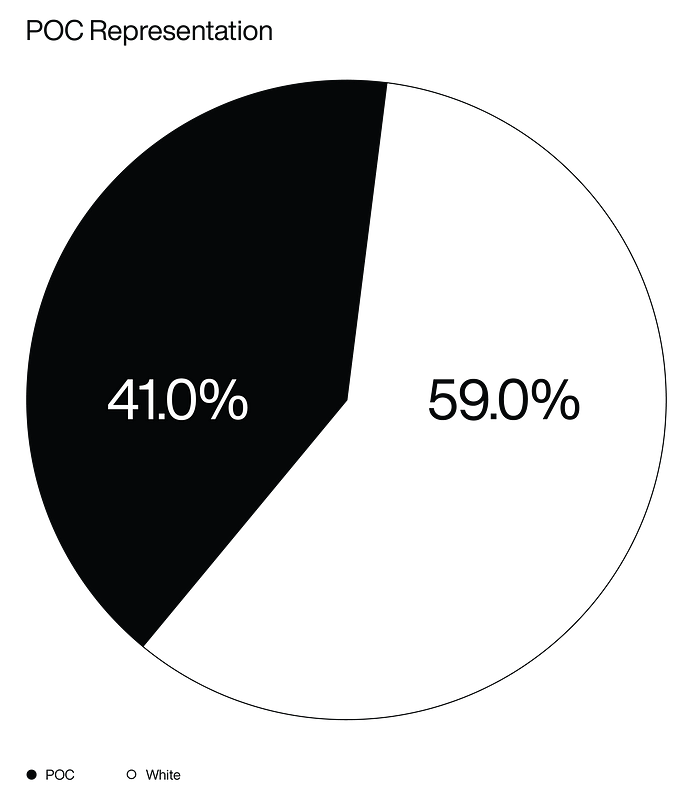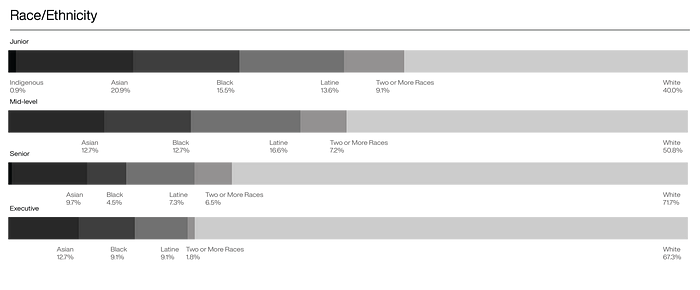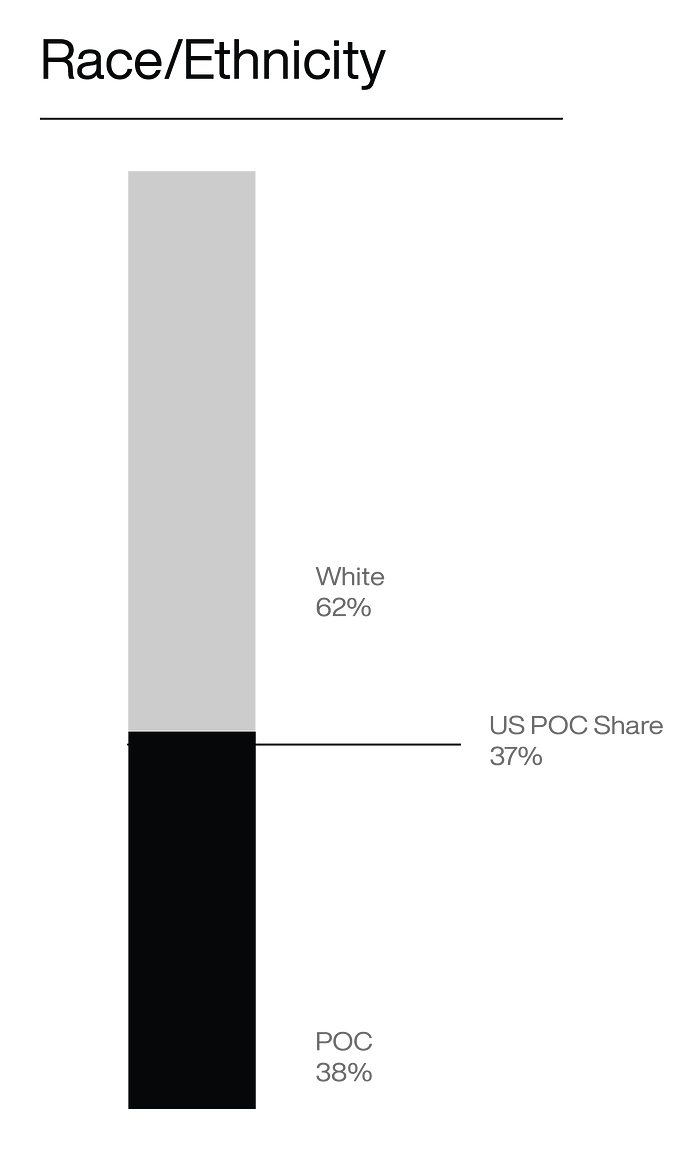
After closing out our first full year of publishing quarterly diversity data as part of our Make / Change commitment to transparency, our first Make / Change report of 2022 both shows progress and highlights areas where we need to evolve more quickly to keep up with employee turnover.
Since we began reporting diversity data in the summer of 2020, we’ve seen two rapid, fundamental changes to the labor market: that a significant number of employees would continue working remotely to some degree, on a permanent basis, and an increase in people changing jobs — or even industries. These changes are affecting employers across the economy, and especially in the creative and technology industries.
By necessity, companies embraced remote work due to pandemic restrictions, disproving myths about how such a shift would impact productivity in the process. With such restrictions lifting, companies are navigating a path forward with various approaches to hybrid work which typically still rely on office mandates. At R/GA, we’re committed to giving our employees true flexibility.
The pandemic also left many employees rethinking work in the context of stagnant wages, rising cost-of-living, and a reassessment of how to value their time. Employees across the country have changed jobs, or even left their given industries, as a result.
Both of these wide-scale changes have been contributing factors shaping our approach to building a more inclusive workplace. As we navigate challenges amid fierce competition for talent, we’re implementing new practices to make our hiring, mobility and promotion practices more equitable, while listening to employees’ needs as we continue our commitment to a flexible working model which we believe contributes to a more inclusive culture.
Who We Are
In Q1 2022, we grew our racial diversity among U.S. talent. More than four out of ten (41%) U.S. employees identify as BIPOC, up 1.6 percentage points (ppt) on the quarter.

The representation of Asian, Latine, and American Indian talent dropped very slightly on the quarter (0.2ppt each). Nearly one out of ten R/GA employees in the U.S., meanwhile, identify as Black, up 1.6ppt for the quarter.
As of Q1, among R/GA’s U.S. talent:
59.0% identify as white (-1.6ppt from Q4 2021)
13.0% identify as Asian (-0.2ppt from Q4 2021)
11.5% identify as Latine (-0.2ppt from Q4 2021)
9.4% identify as Black (+1.6ppt from Q4 2021)
6.7% identify as two or more races (+0.5ppt from Q4 2021)
0.3% identify as American Indian (-0.2ppt from Q4 2021)

We recognize that progress still needs to be made in addressing the underrepresentation of BIPOC employees across different talent levels, although there were improvements in representation at the executive level (defined as group director level and above). There was a 6ppt increase in representation of employees identifying as BIPOC at the executive level since last quarter. 32.7% of executives in R/GA’s U.S. offices now identify as people of color. This was driven by a 4.7ppt increase in Asian representation at the executive level, to 12.7%, and a 3.8ppt increase in Latine representation at the executive level, to 9.1%. People of color remain significantly underrepresented in more senior roles at R/GA — as well as across the industry overall. At R/GA, the senior level (which includes associate director to director roles) has the lowest representation of BIPOC talent, at 28.3%, down by 1.3ppt on the quarter. Representation of BIPOC talent grew at both the junior (+1.8ppt, to 60%) and mid level (+3ppt, now 49.2%). (Mid level roles include experienced professional roles and mid-level manager roles, while junior roles span from interns to professional roles with no management responsibilities and minimal experience.)

55.6% of R/GA employees in the U.S. identify as women, a 2.8ppt increase on the quarter, which more than makes up for the 1 ppt decrease between Q3 and Q4 of 2021.
Representation of women continues to significantly skew towards the junior level, with 70.9% of employees at this talent level identifying as women. The representation of women grew at both the mid (+2.6ppt) and senior (+4.5ppt) levels last quarter, to 58% and 49.4%, respectively. The representation of women at the executive level, meanwhile, dropped slightly (-1.2ppt) on the quarter, to 44.5% — 11.5ppt lower than overall representation of women among U.S. talent. Employees identifying as men continue to make up a disproportionate representation of senior roles, while being underrepresented at the junior level.

What’s Changing
Following a series of changes to our own talent and culture teams in the second half of 2021, this year we aim to make accountability a primary focus at all levels of leadership to make our company more equitable, and are measuring progress in this goal with targets on both Representation — progress in employee diversity — and Belonging — building an internal culture where employees of all race, ethnicity, and gender identities feel welcome and are comfortable being their authentic selves at work. We’ve identified targets for progress in these areas and are holding leaders accountable to these goals quarterly through reviews with our CEO and other top executive leaders.
Our attrition rate rose +1.9ppt on the quarter to 38.4%. However, attrition is 6.6ppt lower for BIPOC employees than the overall workforce, a gap that grew by 2.5ppt on the quarter. Attrition rates for Black talent decreased by 7.7ppt on the quarter. While the attrition rate among Asian women talent dropped by 5.8ppt between Q4 2021 and Q1 2022, they still have the highest attrition rate of any employee demographic, at 44.6%.
One area where we must report a deficit over the past quarter has been in ensuring equitable hiring which addresses historic and ongoing underrepresentation of people of color at R/GA, most prominently in more senior roles.
Of new hires in the U.S. so far this year, 38% identify as BIPOC, a drop of 14ppt from the fourth quarter of 2021, and 6ppt lower than overall representation of BIPOC employees. 64% of new hires in the U.S. year-to-date identify as women, 1ppt below Q4 of 2021, and 8ppt higher than our overall representation of women employees.


Most of our promotions happen in a spring and fall review cycle, so this most recent quarter falls outside our main promotion period. 35% of our internal promotions (7 out of 20) went to people of color, including 75% (3 out of 4) promotions at the executive level. Numbers are too small to be statistically significant: we will have a more comprehensive view of the diversity impact of our promotions after Q2.
Last summer, we announced a commitment to a truly hybrid approach to work which avoids office mandates and offers employees true flexibility. Going forward, we’re affirming our commitment to a distributed creativity model which we believe works best for employees and clients alike by allowing teams to collaborate across departments, offices and regions.
Our people have responded enthusiastically to our flexible approach. We believe this model will contribute to the recruitment and retention of talent, particularly employees from historically underrepresented communities, and help us to create an even better culture at R/GA. Over the past two years, the number of remote employees in the U.S., located outside of commuting distances from R/GA offices, has grown from 1% to 35%.
In short, our workforce is more diverse than in the previous quarter. This is the net outcome of better retention of existing BIPOC talent, offsetting a drop in the proportion of BIPOC new hires. While this is an important step, only around one in three executives (32.7%) come from BIPOC backgrounds — which is 8.3ppt lower than overall BIPOC representation at R/GA. And BIPOC talent remains underrepresented in more senior roles at R/GA more broadly.
We’ve identified continuing to prioritize diversity in talent acquisition efforts and developing talent within our organization as areas of particular importance, especially in hiring or promoting BIPOC employees at the middle, senior, and executive levels. To that end, this quarter, we implemented an Intentional and Inclusive Sourcing Database comprised of over 500 global sources to aid in our intentional recruitment efforts. R/GA Director, Recruitment Operations and ED&I Dani Herrera, who led this effort, was named one of the Top 100 DEI leaders in 2021 by Mogul. We also piloted an Intentional & Inclusive Interviewing Workshop with 45 leaders globally, which will be rolled out across R/GA offices this year.
What Still Needs to Change
Looking ahead to the remainder of 2022, we’re hopeful our commitment to creating an inclusive culture aided by workplace flexibility will continue our progress toward our goals, and we will also introduce new efforts to address racial equity — both within and outside of our company.
We’ve established hiring more equitably across all seniority levels and employee development as top priorities which also represent pathways to retention, as well as addressing rising attrition rates overall. Most crucially, we need to address the lack of representation of BIPOC employees at the senior and executive levels, as well as moving toward more equitable gender representation across seniority levels — particularly women in executive leadership roles, where representation fell last quarter.
In our next report, which will mark two years since we began to publish our quarterly diversity data, we’ll share our annual progress — and some updates on our programs internally, as well as those addressing racial inequities outside of R/GA.
